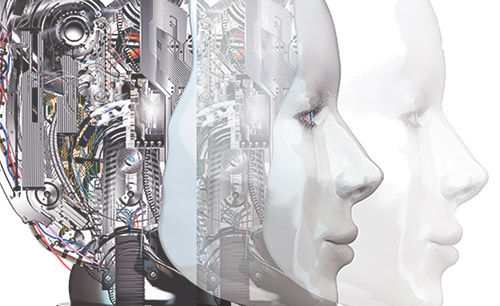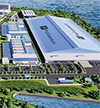The accelerating flow of data has become the driving force for the mushrooming growth of certain key industries that used to be known as “high tech” — they include photonics, 3D printing, robotics, autonomous vehicles, and augmented reality, among others. The phrase “high tech” has lost its meaning since every industry has become technology-driven. “Data is the new currency, across all industries,” says Brian Raymond, the National Association of Manufacturers’ director of Innovation Policy.
The “Connected Age”
What has been the most important technological advance of recent decades — the Internet — is rapidly becoming the Internet of Things (IoT). The “Information Age” has set the stage for the “Connected Age.”
The chipmaker Intel predicts that the total number of connected devices globally will grow from about 10 billion today to 50 billion by 2020. Intel notes these new devices fall into four broad classes, which are on the brink of explosive growth: wearables, home, automotive, and technology for cities and infrastructure.
At the 2017 Las Vegas International Consumer Electronics Show (CES), more than 900 companies displayed innovations for connecting consumer devices into the network. While consumers have been quicker to adapt new technologies, businesses are rapidly catching up. Ericsson, the Swedish telecom and networking firm, projects there will 29 billion connected devices by 2022, 18 billion of them industrial IoT devices in factories, transportation, and the grid.
According to eetimes.com, traffic to the cloud is doubling each year, fueling demand for new technologies ranging from mobile phones to the architecture of data centers. Data centers are ramping their investment in high speed connectivity at a 60 percent compound annual growth rate as they strive to double their data traffic every year.
According to a recent report from Deloitte, “Coverage and signal strength are everything. In telephony, 4G coverage will likely increase and stabilize and 5G will emerge.” Optical communications systems allow for super-speedy data transmission by sending pulses of light through an optical fiber instead of using an electric current to transfer information.
Wireless network capabilities will become more widely available, and easier to move between, says Deloitte. As more corporate work is performed remotely, more and more data will be flowing between data centers and wireless networks, which may be anywhere in the world.
To keep up with the accelerating traffic, data center buildout is booming. Several billion dollars worth of data centers have been announced in 2017. Earlier this year, Las Vegas-based Switch opened its Citadel Campus outside Reno, Nev., bringing online a 1.3 million square foot data center that is the largest co-location facility ever built. The SuperNAP project connects to the main Switch SuperNAP campus in Las Vegas via a fiber loop. Switch plans to create a super loop, which will connect to Los Angeles and also the Bay Area. And in May, Switch, announced plans to develop a more than one-million-square-foot data center campus in Atlanta to meet client demand in the southeastern United States.
In February, Apple announced it would invest about $2 billion in a “global data relevant” data center in Mesa, Ariz. The site is a vacant, 1.3-million-square-foot factory Apple acquired from a bankrupt tech manufacturer. At this facility, Apple plans to implement a 100 percent solar-powered central command center to monitor its other global data centers, according to published reports.
New Investments in Technology for the “Connected Age”
Leading-edge technologies — from IoT to optics/photonics, 3-D printing, robotics, autonomous vehicles, and augmented reality apps — are driving investment across the nation.
-
Switch
NevadaLas Vegas-based Switch opened its Citadel Campus outside Reno, Nev., bringing online a 1.3 million-square-foot data center that is the largest co-location facility ever built.
-
Apple
Mesa, AZApple announced it would invest about $2 billion in a “global data relevant” data center in Mesa, Ariz.
-
City of Rochester
Rochester, NYThe city of Rochester in Monroe County is a regional photonics cluster, with more than 100 OPI (optics, photonics, and imaging) companies, 17,000+ employees, and in excess of $3 billion in annual sales. Monroe County is home to the nation’s Laboratory for Laser Energetics, the University of Rochester Institute of Optics, and the Rochester Institute of Technology.
-
GE Aviation
Peebles, OHGE Aviation has used 3-D printing to build the biggest commercial jet engine in the world. At 11 feet in diameter, the GE9X engine will power the next generation Boeing 777X.
-
3D Systems
San Diego, CAA subsidiary of Silver Spring, Md.-based United Therapeutics Corp., Lung Biotechnology PBC, is collaborating with Rock Hill, S.C.-based 3D Systems to create “solid-organ scaffolds” for human transplants. The project will be based at 3D Systems’ new bio-printing lab in San Diego.
-
Humatics Corp.
Cambridge, MACambridge-based Humatics Corp., a two-year-old startup focused on the intersection of robotics and Internet-connected devices, has raised $16.5 million and is seeking up to $6 million more, according to a recent filing with the U.S. Securities and Exchange Commission.
-
Commsignia Inc.
Santa Clara, CAA research group at the University of Michigan is collaborating with Santa Clara-based Commsignia Inc., a leader in the field of connected car (V2X, Car2X) applications, to extend the capabilities of connected automated vehicles (CAV).
-
Velodyne
San Jose, CAFord acquired ride-sharing service Chariot and invested in Velodyne, a company producing lidar, a laser scanning technology touted as essential for self-driving cars.
-
Cruise Automation
San Jose, CAGM gained self-driving expertise with a startup called Cruise, and partnered with Lyft to put the resulting vehicles on the road.
-
Vuforia
Needham, MAVuforia, an augmented reality (AR) software environment with 40,000 apps, has as many in development. The firm’s number of registered developers increased 76 percent, with most of the growth in China.
According to Transparency Market Research (TMR), the demand for highly capable and efficient electronic products, as well as the rise in data transfer volume, is driving growth in photonics, which is the physical science of light (photon) generation, detection, and manipulation. The global photonics market is set to reach $766 billion by 2020, with a compound annual growth rate of 5.8 percent, according to TMR.
With lasers being used for precision machining and welding, advanced manufacturing sectors that depend on photonics include electronics, ICT, defense, energy, as well as healthcare. The largest end-use industry for photonics is the media, broadcasting, and telecommunications sector due to the rising demand for optical fibers.
The state of New York has developed a growing photonics cluster, led by established optics and imaging companies like Bausch & Lomb, Corning, Kodak, and Xerox, as well as many dynamic, smaller firms. The city of Rochester in Monroe County is a regional photonics cluster, with more than 100 OPI (optics, photonics, and imaging) companies, 17,000+ employees, and in excess of $3 billion in annual sales. Monroe County is home to the nation’s Laboratory for Laser Energetics, the University of Rochester Institute of Optics, and the Rochester Institute of Technology, with established programs in imaging sciences and microelectronics.
3-D Printing Becoming More Accessible
Another exciting new technology, 3-D printing, isn’t actually new, according to NAM’s Director of Innovation Policy Raymond. “It’s been around since the 1970s, but it is just now becoming accessible to companies of all sizes, and is starting to transform a wide range of industries.”
For example, GE Aviation has used 3-D printing to build the biggest commercial jet engine in the world. At 11 feet in diameter, the GE9X engine will power the next generation Boeing 777X. The engine, which took four years to develop, employs a number of new materials, including titanium alloys.
Even more groundbreaking, Silver Spring, Md.-based United Therapeutics Corp. — which has previously focused on pulmonary hypertension drugs — is working to pioneer the practice of human organ manufacturing. The firm is collaborating with a 3-D bio-printing company, Rock Hill, S.C.-based 3D Systems, to create “solid-organ scaffolds” for human transplants. The collaboration with United Therapeutics subsidiary Lung Biotechnology PBC will use patient-specific biological material, including re-differentiated stem cells, to create materials for the transplants. The project will be based at 3D Systems’ new bio-printing lab in San Diego.
Smarter, More Affordable Robotics in Use
Data is the new currency, across all industries. Brian Raymond, director of Innovation Policy, National Association of Manufacturers In workplaces across the U.S., cloud-connected robots are taking over many formerly “human” tasks. The Global Cloud Robotics Market is projected to grow at an annual rate of around 29.2 percent over the next decade to reach approximately $36.64 billion by 2025.
In addition, Boston Consulting Group reports that although robots currently handle only about 10 percent of manufacturing tasks, this number is expected to increase to 25 percent by 2025. Not only will robots become smarter, they will also become more affordable. Increased automation in the workplace could cut labor costs by an average of 16 percent across the world’s 25 largest goods-exporting nations — 22 percent in the U.S. alone — enhancing U.S. global competitiveness.
One of the global centers of robotics R&D and manufacturing has developed in the state of Massachusetts. The three largest robotics manufacturers in the region are Brooks Automation, iRobot, and Symbotic. According to bizjournals.com, the 19 largest robotics companies in Massachusetts (not including large defense contractors or nonprofit labs) reported a combined workforce of 2,486.
One promising firm is Cambridge-based Humatics Corp., a two-year-old startup focused on the intersection of robotics and Internet-connected devices. Humatics has raised $16.5 million and is seeking up to $6 million more, according to a recent filing with the U.S. Securities and Exchange Commission.
Autonomous and Connected Vehicles Generate Excitement
Much excitement is being generated by the development of autonomous and connected vehicles. According to researchers at Goldman Sachs, sales of connected vehicles are projected to pass 60 million by 2020, more than half of all cars sold worldwide. These cars will likely communicate with other cars and jointly make decisions with them to optimize travel patterns, while other connected devices assess the health of passengers and convey useful information to drivers, both about the road and about destinations.
What has been the most important technological advance of recent decades — the Internet — is rapidly becoming the Internet of Things (IoT). The semi-autonomous vehicles market was estimated to be 3.17 million units in 2016 and is projected to reach 7.84 million units by 2021, with a compound annual growth rate of 19.85 percent. The autonomous vehicles market was estimated to be 0.18 million units in 2025 and is projected to reach 1.01 million units by 2030, with compound annual growth of 41.26 percent. The growth mainly results from global vehicle production of 92.6 million units in 2015, compared to 89.9 million units in 2014.
A research group at the University of Michigan is collaborating with Santa Clara-based Commsignia Inc., a leader in the field of connected car (V2X, Car2X) applications, to extend the capabilities of connected automated vehicles (CAV). The ultimate goal is an autonomous car and smart mobility ecosystem that will make driving safer while reducing congestion and lowering emissions.
I-Phone maker Apple has also joined the self-driving car technology race — something the company views as “the mother of all AI projects,” according to CEO Tim Cook.
Legacy automakers Ford and GM are also in the hunt, with each making strategic acquisitions. Ford acquired ride-sharing service Chariot and invested in Velodyne, a company producing lidar, a laser scanning technology touted as essential for self-driving cars. GM gained self-driving expertise with a startup called Cruise, and partnered with Lyft to put the resulting vehicles on the road.
Augmented Reality (AR) Represents a Paradigm Shift
While augmented or “virtual” reality has received much of its exposure through consumer applications, at the Augmented World Expo earlier this year, a wide range of businesses described more practical uses such as hands-free machine maintenance that can be done by novices guided by remote experts.
A number of companies are making “smart glasses” that can do even more than smartphones. Manufacturing firms can use them to communicate instructions to their workers. Companies like Microsoft, Meta, and Magic Leap are developing even smarter headsets. Microsoft has been running trials of its HoloLens headset in architectural firms and medical schools.
“We’re still in early stages of using these devices in business,” Jay Wright, president of Vuforia, an AR software environment with 40,000 apps and as many in development, told eetimes.com. The firm’s number of registered developers increased 76 percent, with most of the growth in China. “There’s a tremendous amount of developer activity…We are on the verge of a paradigm shift in how we interact with information.”



